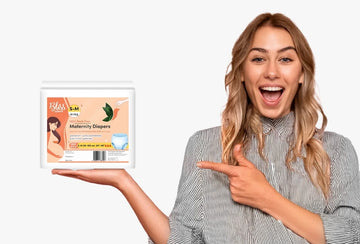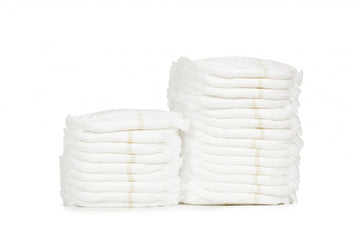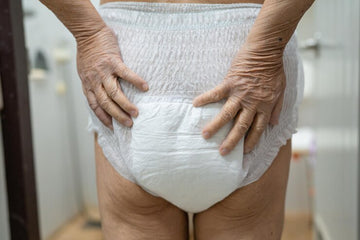Hygiene and health are critical for women's well-being, particularly during menstruation. It's essential to ensure safety and comfort, especially after dark. Disposable period panties and overnight pads are two solutions for protecting yourself during the night that we'll discuss in this blog post. These goods vary in overall efficacy, environmental impact, and cost-effectiveness, among other factors. In contrast to reusable, environmentally more sustainable solutions like nighttime pads, disposable period underwear may be more expensive in the long run. However, they are more convenient. Making decisions based on personal preferences and values is easier when aware of these distinctions. People can prioritize both comfort and environmental responsibility when choosing an alternative by weighing criteria including cost, sustainability, and efficacy.
Why Overnight Protection Is Important?
Comfort and peace of mind at night depend on having consistent one-day safety at some point during the menstrual cycle. It guarantees undisturbed sleep by stopping leaks and stains. Period panties and overnight pads have a higher absorption capacity for extended use, ensuring you wake up light-headed and comfortable. This enables you to start your day without worrying about any injuries.
Why Compare Disposable Period Panties and Overnight Pads?
Comparing Disposable Period Panties with Overnight Pads is intended to highlight their differences, benefits, and general suitability for overnight use. By carefully examining those possibilities, people can make informed selections based solely on their options and wants. While disposable period underwear is comfortable, it might not be as economical or environmentally friendly. Conversely, Nighttime pads are typically more affordable and environmentally friendly, albeit their comfort and absorption capacities could differ. Knowing such factors makes it easier for people to select the appropriate menstruation protection option for themselves in a single day.
Disposable Period Panties
What Are Disposable Period Panties?
Menstrual underwear made explicitly for single usage is known as disposable duration panties. They combine the comfort and security of ordinary underwear with the functionality of a pad. These underwear are made to offer leak-evidence protection, which is especially useful when there is a lot of fluid loss or for one-time use. They also provide integrated absorbency, eliminating the need for extra pads or tampons.
Benefits of Using Disposable Period Underwear
Disposable duration panties offer ease, comfort, and confidence. They are perfect for travel or hectic days because they provide all-in-one protection without requiring additional items. Their great absorbency and leak-proof design ensure fearless intervals, mostly during heavy flow or overnight. Because they are disposable, they also eliminate the need for cleaning and maintenance.
Drawbacks of Disposable Period Underwear
Despite their advantages, disposable period underwear has some disadvantages. It could be more expensive than conventional menstruation products and produce more trash, which hurts the environment. Additionally, some consumers may find it less comfortable than their regular underwear, which may no longer fit as tightly as reusable options. Furthermore, there's probably less variety in styles and sizes than with reusable period underwear.
Overnight Pads
What Are Overnight Pads?
Menstrual hygiene products called overnight pads are intended for use on days with heavy flow or at night. They are wider and longer than regular organic sanitary pads, providing more coverage and absorption capacity to stop leaks even when lying down. Regularly featuring more appealing absorbent cores and leak barriers, nighttime pads offer maximum protection throughout the night, guaranteeing comfort and tranquillity while you sleep.
Benefits of Using Night Pads
Night pads offer dependable security and comfort for extended periods. Due to their length and improved absorbency phases, they are appropriate for heavy flow or extended use, especially overnight. Reducing the chance of spills and stains while you sleep brings you peace of mind. Furthermore, night pads come in various absorbency stages to accommodate unique menstrual needs and are quite convenient.
Potential Downsides of Night Pads
Night pads may have certain disadvantages in addition to their advantages. They may feel heavier than regular biodegradable sanitary pads, which may also lessen some customer's comfort. Their greater size and increased absorbency may also help reduce the cost per pad. Furthermore, certain one-day pads may have plastic components, which may be less breathable and cause discomfort or irritation for sensitive skin.
Comparative Analysis: Disposable Period Panties vs. Night Pads
Financial and Environmental Impact
Disposable period panties and overnight pads differ in their economic and environmental implications. Compared to traditional pads, disposable period panties are less wasteful, require less laundry, and are less affordable per unit. Conversely, although the initial cost of night pads is lower, the waste produced by their frequent use is more significant. Selecting the best solution requires striking a balance between sustainability and cost-effectiveness.
Decision-Making Factors
The decision between disposable period panties and overnight pads is based on personal preferences and requirements. Important considerations include the need for absorbency, comfort, and environmental impact. Disposable period underwear is perfect for those who prioritize comfort and leak-proof safety without dealing with changing pads. On the other hand, night pads are preferred because of their accessibility and ease of use, albeit their post-use disposal raises more environmental concerns.
Conclusion
The decision between disposable period panties and overnight pads often comes down to personal choices, along with consolation, ease of use, and environmental consequences. Although less environmentally pleasant and perhaps more expensive through the years, disposable duration panties offer safety and luxury, making them best for travel or stressful days. Even if they might produce more incredible waste in a single day, pads are appropriate for one-time use and significant flows due to their superior absorbency and style of options. Thinking about absorption wishes, consoling options, and sustainability desires is necessary to make a knowledgeable decision. Ultimately, placing consolation and robust safety first whilst weighing environmental concerns guarantees that a choice aligns with individual dreams at some stage in the menstrual cycle.
FAQs:
How often should I change night pads or period panties?
Disposable period underwear is conveniently incorporated into underwear and made of absorbent materials similar to pads. It can be worn alone or as a backup with other items and has impermeable barriers.
Are there any health risks associated with using these products overnight?
Regular pads are shorter and more absorbent than nighttime pads, allowing better coverage and absorbency to handle higher flows during the night. Their purpose is to stop leaks and make sleeping comfortable.
How can I improve my experience with using these products?
Disposable period underwear offers the convenience of all-in-one protection without additional products like pads. They often have superior leak protection and can be more discreet under clothing.
What are some sustainable alternatives for overnight period protection?
Consider factors such as absorbency needs, comfort during sleep, environmental impact, and personal preferences. Disposable period underwear might be preferred for its integrated design, while nighttime pads are widely available and come in various sizes and absorbency levels.
Can I use disposable period underwear and nighttime pads for added protection?
Both options contribute to waste, but disposable period underwear may have a higher environmental impact due to their integrated design and materials. However, some nighttime pads are also made with biodegradable materials, offering more eco-friendly choices.






